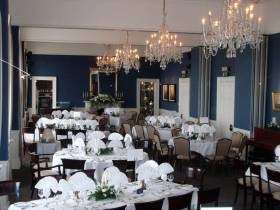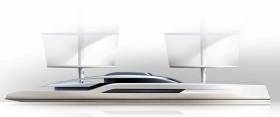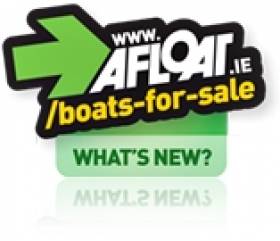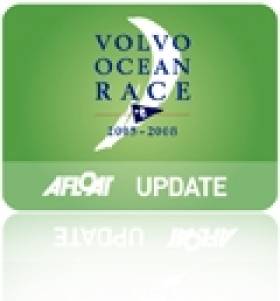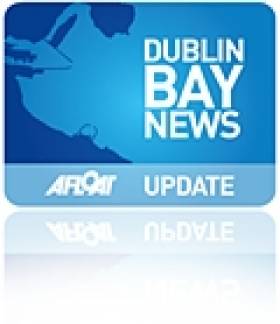Displaying items by tag: Yachts
A Plus (Archambault A 31) is a smaller version of the renowned A35 from the drawing board of Joubert & Nivelt.
Here is a thoroughbred racer for bay & coastal racing and well able for offshore racing & passage making. With a ballast ratio of c 40% and a TCC of 975 this is a yacht that will perform against the bigger 36-footers.
Boarding the open stern one could be on a larger 35+ yacht. A large open racing cockpit which will accommodate a crew of 6/7 in comfort. Carbon tiller with a handle extension. Aft of the helmsman is a large lazarette hatch which will store a liferaft, fenders, fuel cans and the like. The mainsheet trimmer has to hand a 9:1 main and 8:1 backstay. Outboard there is a removable swim/MOB recovery ladder.
All running rig lines are led back to the cockpit with a row of clutches above the companionway. Lewmar 46 two-speed winches for the 105% foresail and two Lewmar 40’s on the coachroof. Barber haulers and jib card lead to the cockpit.
Below there is c 6 foot head room and a practical and well laid out interior that has a standard of finish that exceeds that of many contemporary racing yachts. To starboard there is a navigation station with timber finish and grey work top. Here there is the newly installed B&G Zeus. To the port side a galley with timber surround and grey work top. Here there is a two burner cooker and a cool chest. The varnished timber sole and table contrast with the white internal moulding of the cabin top and sides. Grey settee berths to either side with Alacantra type fabric with the Archambault red sail logo in the centre of each. The coordination of colour in the fabrics and materials makes for a pleasing and comfortable interior that has been coordinated by a designer rather than a production manager, the interior has comfort and style. The forward cabin is accessed by a grey zip flap that can be left open to facilitate the storage of long furled sails. There are plenty of internal grab rails. Aft to starboard is the heads with holding tank. There the fuel tank is stowed and with its opaque PVC allows for easy check on fuel level. The easy unincumbered access to the engine, gearbox and sail drive is a mechanics dream. On the opposite port side a zip flap access to the aft double cabin. Six berths in all.
The Archambault A 31 is the ideal club & offshore racing yacht with fast passage ability. “A Plus” is very well maintained with many upgrades and renewals. Viewing by appointment with Ronan Beirne of Leinster Boats - Network Yacht Brokers Dublin.
Read the full advert on Afloat here
New Members Evening Tonight At National Yacht Club
#NYC - The National Yacht Club hosts an evening for new and prospective members tonight (Friday 28 April) from 7pm to 9pm at the Dun Laoghaire clubhouse’s main dining room.
The evening promises an opportunity to learn about the club’s activities headed into the summer sailing season and year round.
Upcoming opportunities include adult sailing courses that begin in mid May, for those either looking to try sailing for the first time or build on their skills.
New members families and friends are also welcome to attend and explore the many club activities both on and off the water.
Places have been going fast but there may be some openings remaining - contact [email protected] for details.
Dixon Yacht Designs ‘Game Changing’ 70m
UK–based Dixon Yachts has launched a 'game changing' 70–metre design, offering sailing performance and interior space planning normally associated with motor yachts.
DynaRigs have been chosen to maximise the sailing opportunity and minimise the sailing effort. Unlike a conventional rig which requires a small army of crew, this Dyna rigged vessel can be commanded and operated singlehandedly. The twin rigs have been chosen to maximise the sailing efficiency, and the healthy sail area to displacement ratio will assure an exhilarating sailing experience. The tried and tested control systems have proven in-service reliability.
Internally the vessel shares many design characteristics with motor yachts. The main deck features a large bright and airy glazed deck saloon facing aft to the swimming pool, four comfortably proportioned guest cabins and a full width owners cabin incorporating balconies and a featured backlit glass box wardrobe. On the lower deck the guests are provided with a cinema, a spa with sauna and a gym; on the upper deck with the bridge is a formal saloon and the internal dining room.
An embarkation tender platform with direct access into the main deck lobby has been accommodated. The guests can choose between a 7m limousine and a 7m sports tender; the crew have a 6m day to day tender.
This is a statement yacht, for a customer who is not afraid to do something different. It defies sailing convention but not the sailing experience.
#boatsforsale – A new season dawns and already in 2015, there's quite a bit of movement in the Irish boats for sale market after a number of slow years in the Irish second hand boat sector.
In leaner times, Irish brokers have been very successful in the export market and many boats on Irish marinas have been sold abroad but thankfully now the Irish domestic market is showing some green shoots.
It is the smaller, second–hand sailing yachts and cruisers that have been the first to feel the new economic winds at home. The Afloat boats for sale site has 200 sailing craft currently advertised ranging from small yachts and day sailors right up to blue water cruisers.
Here's a brief selection of the latest sailing cruisers on offer:
Westerly GK24 at €5,450 This Laurent Giles Designed Westerly Gk24 Is a flush-deckedproduction cruiser/racer With an 8hp Yanmar Diesel engine And four berths. She is in good condition for her year and comes with a number of sails. Broker Crosshaven boatyard says she is 'priced to sell' at €5,450. For more including photos click: Westerly GK24 at €5,450
Dehler 35 CR at €48,500 A very well cared for 1197 two cabin version, lightly used and well maintained. Excellent specification including warm air heating. If you are seeking an easily handled cruiser equipped for short handled sailing this might be her. For more including photos click: Dehler 35 CR
Beneteau Oceanis Clipper 311 at €49,000 This Oceanis Clipper 311 is an easily handled family cruiser with spacious accommodation in a three cabin lay out. Lifting winged keel and twin rudders allow for shallow anchoring in bays and harbours often denied to most keel yachts. Full suit of electronics to include colour plotter and wheel pilot. It is for sale through Leinster boats who have a range of boats for sale on the Afloat boats for sale site. For more including photos click: Beneteau Oceanis Clipper 311
Westerly Pembroke at €11,450 Tricia is a Westerly Pembroke, the fin keel version of the Centaur. She is number 48 of 97 built between 1976 and 1979. She has all the proven sea keeping qualities of the Centaur but with the greater windward performance and speed that the fin keel brings. Seller Pat Flming says 'I am only selling her as I'm now retired and want a larger boat for extended sailing'. Trish is the 'C' layout with the galley aft by the companion way and the cockpit locker. She has 4 berths, 2 in the forecabin, 1 single and 1 quarter berth in the saloon. Cabins have been relined, rewired & upholstery recovered. Rigging, sails & instruments replaced. For more including photos click: Westerly Pembroke
Tucker 35/36 at €6,750 This sailing yacht was home built by the late Jimmy Dwyer. She was originally launched in the mid 80 and used lightly for 4-5 years only. Wild Pigeon is sloop rigged, long deep keeled marine ply hard chined hull with alum mast /boom, main and roller genoa, Perkins 4108 engine with approx 50 hours only use. Basic internal fitout with internal/ external steering position, galley with 2 rings/grill, 6 berths, porta potti etc. Inventory also includes anchor chain warps fenders/lines. Advertiser Brendan Dunlevy says Wild Pigeon is easily sailed short handed, is suitable for inshore and offshore use and is sitting on her trailer in Dundalk . She is very competitively priced and ready for a new owner to customise and go. For more including photos click: Tucker 35/36
The Afloat boats for sale site has over 400 craft currently advertised ranging from sailing cruisers to motorboats, speedboats, dinghies and ribs. Check them all out HERE.
Massive Fee Increases Proposed for Harbour Yacht Berths
#IRISH HARBOURS - Yachts berthing at Ireland's main fishing harbours could see their charges hiked by an incredible 800 per cent.
According to The Irish Times, Marine Minister Simon Coveney has announced a mere 21 days for comment and consultation on the draft Fishery Harbour Centres (Rates and Charges) Order 2012. The consultation document is attached to the bottom of this post and available to download as a pdf.
The proposed new charges include an annual fee of €250 per metre for yachts, which could see a 10-metre yacht currently paying €312 a year for a berth shell out as much as €2,500 annually for the same space.
Additional water and electricity costs could even see this bill rise to €3,100 - for berths that come "without proper marina facilities in most cases".
The proposals apply to the State's six fishery centres at Killybegs, Rossaveal, Dingle, Castletownbere, Dunmore East and Howth, only two of which have pontoons suitable for leisure boats.
The Irish Times has more on the story HERE.
Ailsa Craig Race Celebrates 50th Anniversary
#RACING UPDATE - This summer the Royal Ulster Yacht Club will stage the 50th anniversary edition of the Ailsa Craig Race, one of the classics of the Northern Ireland offshore yacht racing calendar.
Many of the competitors from the inaugural race in 1962 - several of whom are now in their 80s - are expected to compete in the overnight challenge, which takes the fleet from Bangor to the rock at the mouth of the Clyde in Scotland.
The 2012 Ailsa Craig Race, sponsored by Hamilton Shipping, takes place on 15 June.
'The Rules of Racing' Lecture in Castlebar This Thursday
#RACING - Mayo Sailing Club's winter series of lectures continues this Thursday 23 February with a talk by Ed Alcock on 'The Rules of Racing'.
Alcock is racing manager of the Irish Sailing Association (ISA), and his lecture will outline the laws that govern racing by windpower on the water in Ireland, covering classes from yachts and dinghies to windsurfing, kitesurfing and more.
Topics to be covered include rights and obligations on the water, giving way, keeping clear, red flags and protest forms.
Sailors of all craft are invited to attend the evening, and anyone wanting to get involved in racing is also welcome, especially with the 2012 racing season only eight weeks away.
Alcock's talk takes place this Thursday at 7.30pm in GMIT Castlebar. The Galway Advertiser has more HERE.
VOR Second Leg Cut Short Over Piracy Concerns
#VOLVO OCEAN RACE - The second leg of the Volvo Ocean Race from Cape Town to Dubai has been cut short by organisers as a result of the growing threat of piracy in the Indian Ocean, The Irish Times reports.
The six yachts competing will be protected by armed guards as they are shipped on a secret route to the United Arab Emirates due to piracy concerns.
The boats will be transported by ship from an undisclosed location to Sharjah in the Arabian Gulf, from where they will sprint to the finish line in Abu Dhabi.
All six teams are currently in Cape Town, with Team Sanya, PUMA and Abu Dhabi Ocean Racing hoping to get back in the race after retiring in the first leg.
As previously reported on Afloat.ie, NATO recently foiled a pirate attack on a Spanish fishing vessel between the Seychelles and the Somali coast.
The Irish Times has more on the story HERE.
At the same time across Dublin Bay, the Norwegian square-rigged tallship Statsraad Lehmkuhl was underway from her River Liffey berth at Sir John Rogersons Quay, where the 321" foot vessel had made a two-day visit to Dublin Port.
As the public boarded one of the largest tallships in the world, they were given a taste of what to expect a year from now, as the capital prepares to be the host-port of the final race-leg of the Tall Ships Races. The sailing spectacle was last held in 1998 and the high-profile event in August 2012 is expected to draw around 100 tallships.
Roland Jourdain To Visit Dublin With New MOD70
Renowned yachtsman Roland Jourdain will be visiting Ireland next month to show off his new vessel ahead of the Fastnet Race.
A veteran of 60-foot monohulls, Jourdain will be in Dun Laoghaire from 4-5 August to test his new Veolia Environnement MOD70 trimaran, as well as select crews for next year's transatlantic races.
His new MOD70 is the second in a series of 12 that will begin racing next summer when six of the fleet race from New York to Brest in France. But the first test will be at the Fastnet, where he will race the only other MOD70 on the circuit.
The Veolia Environnement MOD70 will be berthed adjacent to the Royal St George Yacht Club for anyone curious to have a peek. For more details on the vessel and on Roland visit www.multionedesign.com and www.canyousea.com.


























